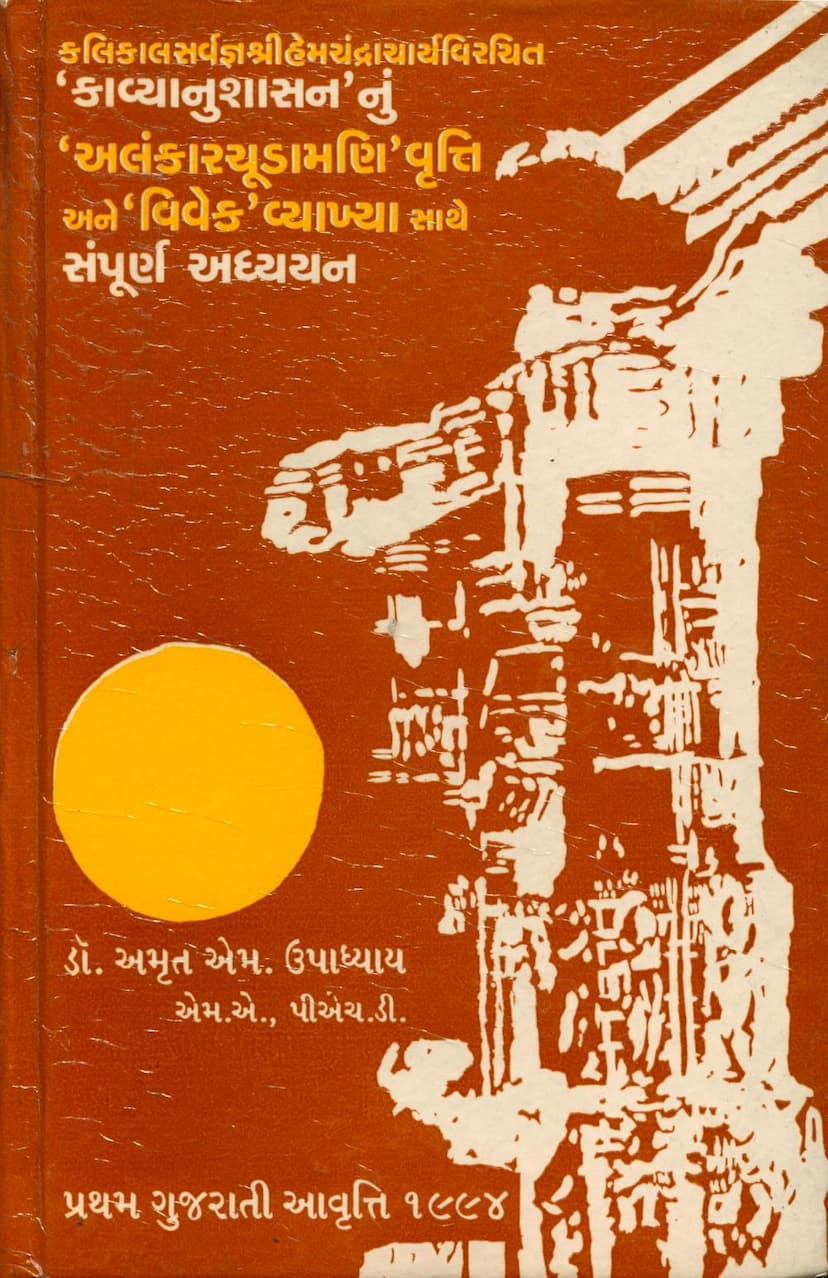Kalikalsarvagna Shree Hemchandracharya Virachit Kavyanushasannu Alankar Chudamani Vrutti Ane Vivek V
Added to library: September 2, 2025

Summary
Based on the provided Gujarati text, here is a comprehensive summary in English of the book "Kalikalsarvagna Shree Hemchandracharya Virachit Kavyanushasannu Alankar Chudamani Vrutti ane Vivek Vyakhya Sathe Sampurna Adhyayan" by Prof. Dr. Amrut M. Upadhyay.
Book Title: Kalikalsarvagna Shree Hemchandracharya Virachit Kavyanushasannu Alankar Chudamani Vrutti ane Vivek Vyakhya Sathe Sampurna Adhyayan (A Complete Study of Kalikalsarvajña Shri Hemachandracharya's Kāvyānuśāsana with the Gloss Alamkāracūḍāmaṇi and the Auto Sub-commentary 'Viveka').
Author: Prof. Dr. Amrut M. Upadhyay, M.A., Ph.D.
Publisher: Amrut M Upadhyay / Saraswati Pustak Bhandar
Publication Year: 1994 (First Gujarati Edition)
Overview:
This book is a comprehensive, critical, and comparative study of Shri Hemachandracharya's renowned Sanskrit work, the Kāvyānuśāsana. The study is presented in Gujarati and is based on the author's Ph.D. thesis. It delves deeply into Hemachandracharya's Kāvyānuśāsana, his self-authored gloss Alamkāracūḍāmaṇi, and the sub-commentary Viveka. The author, Prof. Dr. Amrut M. Upadhyay, aims to fill the gap in providing a thorough academic examination of this tripartite Jain text on poetics and literary science.
Key Aspects and Contributions of the Study:
-
Re-evaluation of Kāvyānuśāsana's Position: The study challenges the common perception of Kāvyānuśāsana as merely a textbook following Mammata's Kāvyaprakāśa. Dr. Upadhyay argues that, from a theoretical standpoint, Kāvyānuśāsana is a highly significant work within the Kashmirian tradition of Sanskrit poetics and the Dhvani (suggestion) theory. He asserts that Kāvyānuśāsana stands as a crucial text in the history of the Dhvani school, rivaling the literary critiques of Anandavardhana and Abhinavagupta. The study emphasizes that Kāvyānuśāsana holds the status of an authoritative and seminal work in Indian poetics, comparable to Kāvyaprakāśa and Sahitya Darpana.
-
Emphasis on the Tripartite Structure: The study meticulously examines all three layers of Hemachandracharya's work: the sūtras (aphorisms), the Alamkāracūḍāmaṇi gloss, and the Viveka commentary. The author highlights how this tripartite structure contributes to the depth and comprehensiveness of the Kāvyānuśāsana, making it an invaluable resource for scholars.
-
Theoretical and Ideological Insights: The study provides a fresh perspective on the theoretical and ideological aspects of Kāvyānuśāsana. It argues that Hemachandracharya's work is firmly rooted in the Dhvani tradition, which considers Dhvani or Rasa (aesthetic experience) as the soul of poetry.
-
Scholarly Rigor and Methodology: The book is built upon extensive research, involving the careful study of numerous ancient Sanskrit texts and the writings of prominent modern scholars in the field. The author expresses gratitude to numerous scholars whose works provided significant guidance.
-
Detailed Analysis of Kāvyānuśāsana's Content: The study covers the entirety of Kāvyānuśāsana, systematically analyzing its eight chapters.
- Chapters 1-6: Focus on core Sanskrit poetics, including the purpose of poetry (kāvya prayojana), the causes of poetry (kāvya kāraṇa), poetic training (kavi śikṣā), poetic conventions (kavisamaya), poetic imitation (haraṇa), the definition of poetry (kāvalakṣaṇa), poetic elements (quality, fault, ornament), the theory of sound and meaning (śabdārtha), the concept of Dhvani (suggestion), and the nature of aesthetic experience (rasa).
- Chapters 7-8: Deal with characterization (hero and heroine types) and literary genres (kāvya prakāra), respectively.
-
Author's Unique Contributions: Dr. Upadhyay's study is lauded for:
- Presenting a comprehensive, detailed, and critical analysis of Kāvyānuśāsana, its gloss, and its commentary, which was previously unavailable.
- Highlighting Hemachandracharya's significant contribution to the Rasa-Dhvani tradition, placing him at a very high and respectable position among Sanskrit literary theorists.
- Demonstrating that Kāvyānuśāsana is a foundational text for understanding the development of Indian poetics, particularly the Kashmirian school and the Dhvani theory.
- Showcasing Hemachandracharya's scholarly acumen in synthesizing the knowledge of his predecessors, presenting it clearly and accessibly for future generations.
- Emphasizing the work's structural sophistication and its value as a reference for students of Sanskrit and Prakrit literature.
-
Dedication and Acknowledgements: The book is dedicated to all ancient and modern scholars in the field. The author acknowledges the inspiration drawn from the Saraswati of Shri Hemachandracharya, who is considered to have conquered the Tamraparni river with her word-gems. The author also expresses gratitude to various institutions and individuals who supported the publication.
In essence, Dr. Amrut M. Upadhyay's study is a seminal work that resurrects and re-contextualizes Hemachandracharya's Kāvyānuśāsana within the broader landscape of Sanskrit literary theory, particularly highlighting its crucial role in the development and understanding of the Dhvani and Rasa theories. It is a testament to the author's profound scholarship and dedication to Jain intellectual heritage.